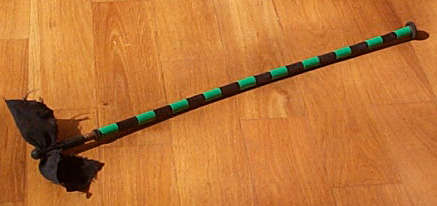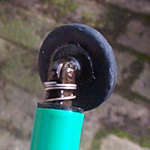|
|
 PAINTBALL GUNSThere are two main varieties of gun (or 'marker' if you want to be more politically correct), semi-automatics and pump action. All guns have a bolt which releases the gas from the end of it and this goes backwards and forwards allowing one ball at a time to drop from the hopper into the end of the barrel. On a pump this bolt is manually moved because it is directly connected to the pump handle. A semi, however, uses gas pressure to recock the gun automatically. Squeegees
If you can't get a squeegee then turn your gun upside down and fire
some gas through it to try to blow out as much paint as possible. This
isn't particularly effective, but is better than nothing.
PumpsPumps are a little harder to use than a semi. You can't achieve the same rate of fire and working the pump handle means that you have to adopt certain firing postures and can't fire one handed. Having said that they are extremely reliable and I like the extra element of skill they add. Virtually all site guns used to be pumps but cheaper semis have more or less rendered them obsolete. A good pump also tends to be more accurate then budget semis, probably because there isn't the recoil from the bolt recocking. Chambering more than one paintball The most common problem people have with pumps is chambering more
than one ball by working the pump more than once before pulling the
trigger. If this happens they will either all come out very slowly (if
you are lucky), or they will smash in the barrel and need cleaning out
with a squeegee. To avoid this try to remember only to chamber a ball
when you are just about to fire. If you are not sure whether there is
already one there or not then you can tell by feeling the pump handle.
If it has not been cocked then there will be a slight resistance because
the handle is pushing against a spring. Once the pump has been cocked
then this resistance will no longer be there.
SemisFailing to recock Sometimes the gun will make a loud BRRrrrap noise as if firing very
fast, and then stops with the bolt in the forward (uncocked) position.
. If this happens you will need to cock it manually. Simply pull back
the cocking handle (on the left hand side of the gun just below the
hopper) until it clicks. If this happens again then you are almost certainly
low on gas, and you will need a fresh bottle. If you hear an opponent's
gun make this noise then it may well be out of operation or firing slow
paintballs due to low gas, so this is the ideal time to have a pop at
getting them while they can't return fire effectively. Devious players
however, may deliberately block the cocking handle by putting their
thumb in the way, causing the BRRrrap noise and tricking their opponents
into thinking they have a gun problem. (Take care doing this - I will
accept no responsibility for bruised fingers).
GEARHeadgearMost sites supply heavy padded hoods which are too hot in all but the coldest weather and also make it harder to hear. Bush hats, baseball caps and scrim netting make suitable substitutes. Players tend to become an amorphous mass in their site clothing, so wearing something distinctive will enable your friends to identify you. GogglesIt's vital to have good goggles because otherwise they will steam up very easily, consequently as a regular player you will probably get better value out of buying your own goggles than your own gun. The most important thing is to have a good seal at the bottom of your goggles, otherwise hot damp air from your mouth will get in and steam them up. Make sure that your goggle strap is reasonably tight and joggle them around a bit so that they seal well. If you have your own goggles then you can prepare them beforehand. Take a piece of kitchen towel, (don't use toilet roll, because it breaks up too easily), add a small amount of washing-up liquid and then a splash of water. (This is a delicate balance. If there is too much water then bubbles will form, but if there is too little water then the consistency will be too thick and ridges of detergent will be formed). Wipe the kitchen towel over the inside of the goggles in smooth strokes to leave a fine film of washing-up liquid. In a couple of minutes when this has dried it will be extremely difficult for condensation to form on it. It's not practical to do the washing up liquid trick in the field, but with practice you should get time in the safe zone between games. Paint on the GogglesGoggles frequently get spattered with spray from paintballs hitting the cover that you are hiding behind. It is usually best to resist the temptation to wipe it, (or to let a marshal wipe them), as it will then smear and completely cloud your vision. You will always need water to get them clean. I carry some in a small 'inkdropper' type bottle in my pocket. ClothingOne major problem is overheating. Lots of people turn up in jeans and a shirt, and then put the site overall over the top. Unless it is midwinter, as soon as you start moving in this lot you will be boiling hot and sweat like a pig. This is bad in so many ways, you'll be uncomfortable, you won't have the energy to run and worst of all your goggles will steam up immediately. Aim to wear only one layer of clothing, which will be the one you go in. The paint will wash out provided you don't leave it for days, so don't worry too much about staining. I wear a faded black hooded top, combat trousers (which have lots of handy pockets), a bush hat and scrim net, which is a lot less hot than the heavy padded hoods which sites tend to issue. Fingerless GlovesPaintballs often hit you on the hands because when firing over cover they form quite a large portion of the visible area. Unfortunately being hit here really hurts and at close range the skin will usually be broken, as there is little fat or muscle on them to absorb an impact. Gloves are therefore definitely advisable but use fingerless gloves because otherwise you won't be able to operate your gun or open paintball pots. I just use a £1.99 pair of black woollen fingerless gloves, which are available from camping/army surplus shops, but you can get flash paintball ones for ten times the price. Footwear
Take a spare pair of shoes to change into when you get back to your car, and a carrier bag to put the old ones in. Smoke and Paint GrenadesThese are rubbish. Don't even think about it. (Smoke is OK indoors but blows away too easily outside). I have never, ever seen anyone get eliminated with a paint grenade. The only use I can think of is for throwing them at someone to panic them and then shooting them as they run away. PaintballsTry to resist the temptation to blaze away at the target range just outside the safe zone - save your paintballs for targets that are shooting back. If picking up used paintballs, check that they are not damp and that there are no soft patches or dimples on them or they will burst in the barrel. NewspaperThere are often significant pauses between games and if you are punctual there is often a big difference between the time that you arrive and the time the first game starts. Having something to read will pass the time, and at the end of the day you can take it apart and cover your car seats to stop them being caked in mud. | ||

©2002. All rights reserved.
| |||


 If
a ball breaks in the barrel then your gun will not shoot straight until
it is cleaned out with a squeegee. This is usually a rod with a moveable
rubber disk on the end, which is pushed in with the disk at an angle
and then pulled out with the disc filling the whole barrel. Marshals
virtually always carry them, so shout for one.
If
a ball breaks in the barrel then your gun will not shoot straight until
it is cleaned out with a squeegee. This is usually a rod with a moveable
rubber disk on the end, which is pushed in with the disk at an angle
and then pulled out with the disc filling the whole barrel. Marshals
virtually always carry them, so shout for one.